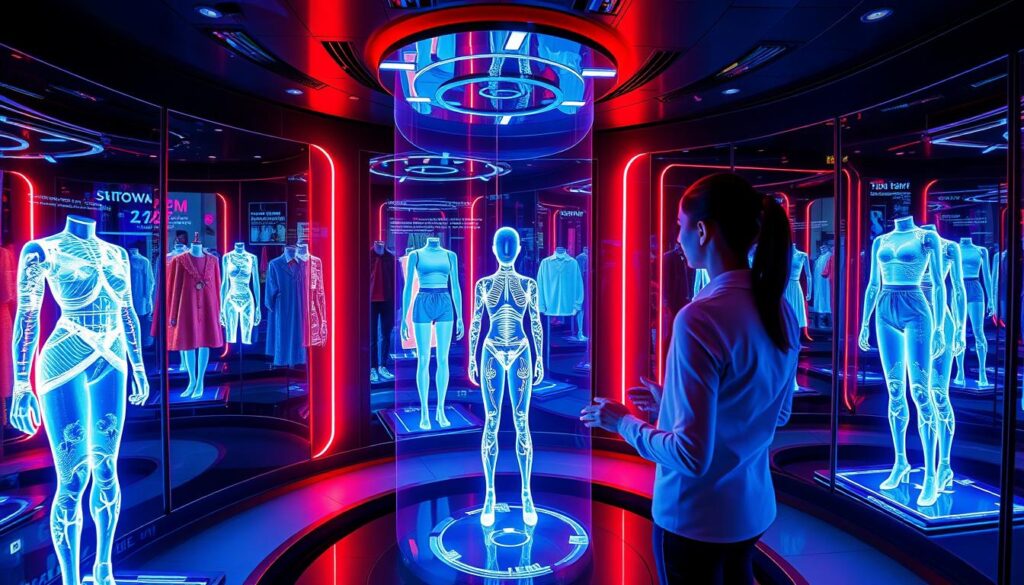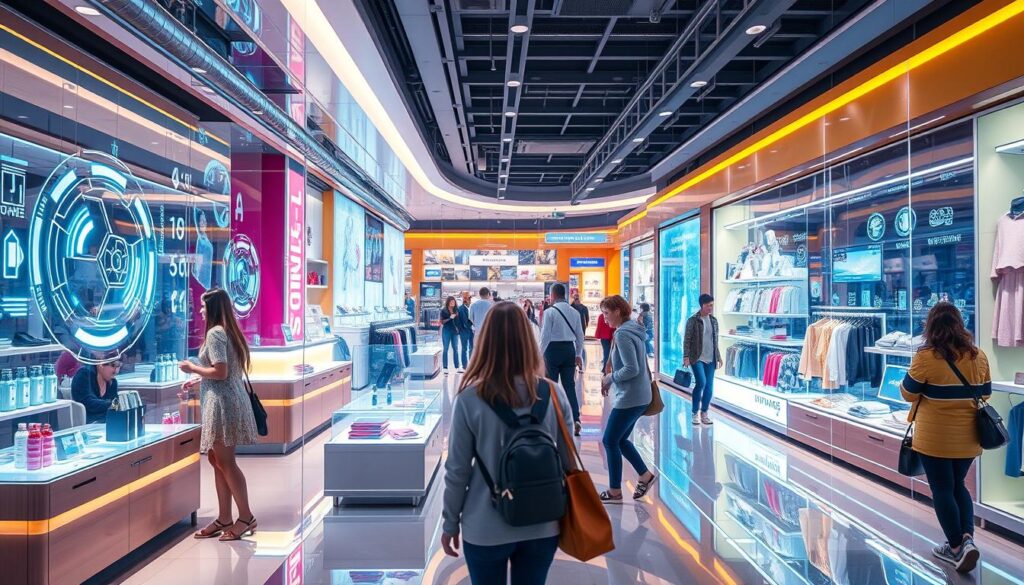The shopping world is changing fast, thanks to AI and AR. These technologies are creating amazing new ways to shop. Artificial Intelligence (AI) and Augmented Reality (AR) are combining to make shopping more interactive and personal than ever.
This change isn’t just about cool new gadgets. It’s about changing how we shop with brands and products. AR and AI are bringing us into a future where shopping is more engaging. This means we can look forward to shopping in ways we’ve never imagined before.
Key Takeaways
- AI and AR are pioneering the transformation of traditional shopping into immersive consumer experiences.
- The synergy between AI-enhanced shopping and AR shopping technologies is setting new future retail trends.
- This evolution emphasizes increased interactivity and personalized customer engagement.
- The shift towards more immersive shopping environments is redefining consumer-brand interactions.
- Understanding these advancements is critical as they pave the way for the future of retail.
Introduction to AI and Augmented Reality (AR) in Shopping
The way we shop is changing fast. The mix of AI and AR in retail is making shopping with brands more fun and personal. This combo brings shopping to life, letting customers mix the online and in-store worlds. It’s pushing shopping into a new digital era.
Defining AI and AR in Retail
AI in retail means machines learning from data to make shopping better. It can figure out what shoppers might like, spot trends, and suggest products just for them. For example, Amazon’s smart suggestions drive a big part of its sales.
AR lets shoppers see how things would look or fit in real life but through a screen. IKEA Place, for example, lets people check out furniture at home before buying. AI and AR together make shopping smoother and more fun for everyone.
Importance of Immersive Shopping Experiences
Today, giving shoppers a great experience is key to keeping them coming back. Most people say they care as much about how they buy as what they buy. Also, a lot like the idea of using AR for a more lively shopping trip.
Brands that use tech to offer quick, custom service win big. Meeting today’s shopper’s wants for speed and personal touches boosts satisfaction. And happy customers stick around, helping businesses grow.
| Statistic | Data |
|---|---|
| Customer importance on experience | 80% |
| Preference for AR shopping | 61% |
| Expectation for faster service | 81% |
| Expectation for better personalization | 73% |
Current Trends in Immersive Shopping Technologies
The retail world is changing fast. Now, new tech is making online shopping better than ever. Virtual fitting rooms and AI shopping assistants are leading the change. They make shopping online feel just like you’re in the store.
Virtual Try-Ons
Shopping for clothes and accessories online is getting a big upgrade. With AR, virtual try-ons let you see how you’d look in items from home. This tech makes shopping online clear and boosts your confidence in buying.

Brands like Warby Parker and Sephora show how effective virtual fitting rooms can be. They let you see makeup or glasses on you. This reduces returns and makes shopping more fun.
Personalized Shopping Assistants
AI shopping assistants are changing the game in online shopping. They understand what you like by analyzing your choices. Then, they suggest products you might like, making shopping easy and fun.
Take Amazon’s AI, for example. It makes good guesses on what you’ll want to buy. This makes shopping fast and boosts your satisfaction.
“The future of retail lies in technology that provides immersive, personalized experiences, whether through virtual fitting rooms or AI shopping assistants.”
By using AR and AI, shops are offering a shopping experience that’s smooth, fun, and very personal.
- Virtual fitting rooms enhance customer confidence and reduce return rates.
- AI shopping assistants offer personalized product recommendations.
- Brands like Warby Parker and Sephora are leading the way in adopting these technologies.
How AR Enhances the Online Shopping Experience
Augmented Reality (AR) turns online shopping into a fun and interactive activity. AR technology in retail lets brands give buyers a deeper, customized shopping experience. Now, customers can see how products look in real-life settings, thanks to AR. This helps mix the digital with the real world.
A key benefit of AR for online shopping is letting users view 3D product models at home. This helps them make informed choices by understanding product size, colors, and how it works.
AR’s use in e-commerce has shown positive results:
| Statistic | Details |
|---|---|
| Customer Expectations | 61% of shoppers like AR to see products before they buy. Plus, 80% say the shopping experience is as key as the product or service. |
| Business Adoption | Many brands use AR technology in retail for better customer experiences. This makes shopping more engaging and fun. |
| Enhanced Conversion | AR boosts sales, as 89% of buyers are convinced by a product video to make a purchase. |
| Service Improvement | 81% of shoppers want quick service, and 73% look for personalized shopping. AR improves these, offering enhanced shopping experiences with AR. |
Retailers using AR can meet customer demands. As 65% expect firms to adapt to their needs, using AR to stay ahead is essential. High-tech phones with LiDAR make AR even smoother on different devices.
AR is reshaping online shopping’s future. It makes shopping more lively and interactive, boosting customer happiness and loyalty. As AR tech evolves, retailers can offer better experiences. This leads to more sales and keeping customers.
The Role of AI in Personalizing Customer Experiences
AI personalization is changing how businesses interact with customers. It creates unique experiences that align with individual needs. AI improves customer service and offers real-time help. This shift is thanks to more machine learning in shopping. AI chatbots are also making consumer interactions smoother.
Machine Learning and Predictive Analytics
Machine learning and predictive analytics are key in the retail world. They analyze shopping habits to predict what consumers will want next. These tools help businesses offer custom recommendations and manage inventory better.
For instance, predictive analytics can tell which items will be popular soon. This lets stores stock up in advance. Combining data insights with understanding customer behavior makes shopping better for everyone.
| Product | Price | Warranty |
|---|---|---|
| Amazon Kindle Kids | $129.99 | 2 years |
| Amazon Kindle Paperwhite | $159.99 | 1 year |
| Rakuten Kobo Clara BW | $129.99 | 1 year |
| Logitech MX Ink stylus | $129 | 1 year |
| Kindle Colorsoft | $279.99 | 1 year |
Chatbots and Conversational Interfaces
AI chatbots and conversational interfaces are key in retail today. They offer real-time help, improving customer service. These smart tools answer questions instantly, making shopping easier.
By using natural language processing, chatbots understand and react to customer questions. This makes interactions feel more personal. With these technologies, customers get fast and accurate info, enhancing their shopping experience.
In conclusion, using AI in retail for personalization is shaping a new future. Technologies like machine learning, predictive analytics, and chatbots are central. They allow retailers to meet customer needs uniquely. This is setting a higher standard in the industry.
Combining AR and AI for Ultimate User Engagement
The mix of AI and AR tech is changing the way we shop by making it more engaging. AI and AR together let shops create shopping worlds that are fun, fast, and fit each customer’s likes. This new shopping era with AI and AR means customers will see fresh, creative ways to explore products and services.
When AI and AR work together, they help collect useful data about how users shop. AI uses this data to learn what customers like and predict trends. Shops can use these insights to get better, manage stock well, and create marketing that really speaks to the customer. This combo doesn’t just bring in more people; it makes shopping better and more tailored for everyone.
Also, AI and AR make shopping live and interactive in a way that’s both fun and smart. Imagine seeing how a new sofa looks in your room before buying it. Or getting suggestions for things you’ll like based on what you’ve looked at before. This blend of tech makes sure you get info that’s right for you, making shopping a happier, more satisfying experience. As tech grows, AI and AR will keep finding new ways to surprise and please shoppers.
FAQ
What are AI and Augmented Reality (AR) in the context of retail?
Why are immersive shopping experiences important?
How do Virtual Try-Ons work?
What are AI-powered shopping assistants?
How does AR enhance the online shopping experience?
What roles do Machine Learning and Predictive Analytics play in retail?
How do AI-driven chatbots improve customer service?
What are the benefits of integrating AI and AR in retail?
Source Links
- https://www.screendaily.com/news/attendees-laud-new-look-geneva-digital-market/5199017.article
- https://pctechmag.com/2024/11/uict-avr-lab-to-transform-stem-education-with-mixed-reality/
- https://www.salesforce.com/uk/commerce/ecommerce-merchandising/
- https://medium.com/@sourenstepanyan/the-daily-tech-digest-8-november-2024-6b21b79dd91a
- https://finance.yahoo.com/news/lucid-gravity-now-available-configure-140000072.html
- https://vocal.media/journal/future-of-digital-advertising-in-fort-collins-trends-and-predictions
- https://www.openpr.com/news/3725479/karaoke-market-thriving-demand-2024-2032-with-industry
- https://www.xrtoday.com/augmented-reality/are-smart-phones-the-best-avenue-for-enterprise-xr/
- https://www.digitalengineering247.com/article/design-simulation-summit-artificial-intelligence-and-simulation/Simulation
- https://thegadgetflow.com/blog/best-e-readers/
- https://www.xrtoday.com/reviews/logitech-mx-ink-review-creativity-in-extended-reality/
- https://techbullion.com/transforming-software-engineering-innovations-in-optimization-quantum-computing-and-user-centric-design/



